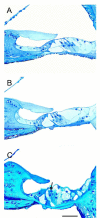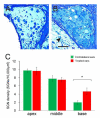Connexin 26 null mice exhibit spiral ganglion degeneration that can be blocked by BDNF gene therapy
- PMID: 24333301
- PMCID: PMC3946535
- DOI: 10.1016/j.heares.2013.11.009
Connexin 26 null mice exhibit spiral ganglion degeneration that can be blocked by BDNF gene therapy
Abstract
Mutations in the connexin 26 gene (GJB2) are the most common genetic cause of deafness, leading to congenital bilateral non-syndromic sensorineural hearing loss. Here we report the generation of a mouse model for a connexin 26 (Cx26) mutation, in which cre-Sox10 drives excision of the Cx26 gene from non-sensory cells flanking the auditory epithelium. We determined that these conditional knockout mice, designated Gjb2-CKO, have a severe hearing loss. Immunocytochemistry of the auditory epithelium confirmed absence of Cx26 in the non-sensory cells. Histology of the organ of Corti and the spiral ganglion neurons (SGNs) performed at ages 1, 3, or 6 months revealed that in Gjb2-CKO mice, the organ of Corti began to degenerate in the basal cochlear turn at an early stage, and the degeneration rapidly spread to the apex. In addition, the density of SGNs in Rosenthal's canal decreased rapidly along a gradient from the base of the cochlea to the apex, where some SGNs survived until at least 6 months of age. Surviving neurons often clustered together and formed clumps of cells in the canal. We then assessed the influence of brain derived neurotrophic factor (BDNF) gene therapy on the SGNs of Gjb2-CKO mice by inoculating Adenovirus with the BDNF gene insert (Ad.BDNF) into the base of the cochlea via the scala tympani or scala media. We determined that over-expression of BDNF beginning around 1 month of age resulted in a significant rescue of neurons in Rosenthal's canal of the cochlear basal turn but not in the middle or apical portions. This data may be used to design therapies for enhancing the SGN physiological status in all GJB2 patients and especially in a sub-group of GJB2 patients where the hearing loss progresses due to ongoing degeneration of the auditory nerve, thereby improving the outcome of cochlear implant therapy in these ears.
Copyright © 2013 Elsevier B.V. All rights reserved.
Figures








Similar articles
-
The effect of deafness duration on neurotrophin gene therapy for spiral ganglion neuron protection.Hear Res. 2011 Aug;278(1-2):69-76. doi: 10.1016/j.heares.2011.04.010. Epub 2011 May 1. Hear Res. 2011. PMID: 21557994 Free PMC article.
-
Cochlear implants and ex vivo BDNF gene therapy protect spiral ganglion neurons.Hear Res. 2007 Jun;228(1-2):180-7. doi: 10.1016/j.heares.2007.02.010. Epub 2007 Mar 7. Hear Res. 2007. PMID: 17416474 Free PMC article.
-
Abnormal Innervation, Demyelination, and Degeneration of Spiral Ganglion Neurons as Well as Disruption of Heminodes are Involved in the Onset of Deafness in Cx26 Null Mice.Neurosci Bull. 2024 Aug;40(8):1093-1103. doi: 10.1007/s12264-023-01167-x. Epub 2024 Feb 4. Neurosci Bull. 2024. PMID: 38311706 Free PMC article.
-
Neurotrophic factors and neural prostheses: potential clinical applications based upon findings in the auditory system.IEEE Trans Biomed Eng. 2007 Jun;54(6 Pt 1):1138-48. doi: 10.1109/TBME.2007.895375. IEEE Trans Biomed Eng. 2007. PMID: 17551571 Free PMC article. Review.
-
Neurotrophin gene therapy to promote survival of spiral ganglion neurons after deafness.Hear Res. 2020 Sep 1;394:107955. doi: 10.1016/j.heares.2020.107955. Epub 2020 Apr 5. Hear Res. 2020. PMID: 32331858 Free PMC article. Review.
Cited by
-
Viral-mediated Ntf3 overexpression disrupts innervation and hearing in nondeafened guinea pig cochleae.Mol Ther Methods Clin Dev. 2016 Aug 3;3:16052. doi: 10.1038/mtm.2016.52. eCollection 2016. Mol Ther Methods Clin Dev. 2016. PMID: 27525291 Free PMC article.
-
Recording potentials from scala media, saccule and utricle in mice.J Otol. 2015 Jun;10(2):87-91. doi: 10.1016/j.joto.2015.09.003. Epub 2015 Sep 30. J Otol. 2015. PMID: 29937788 Free PMC article.
-
Kölliker's organ and the development of spontaneous activity in the auditory system: implications for hearing dysfunction.Biomed Res Int. 2014;2014:367939. doi: 10.1155/2014/367939. Epub 2014 Aug 20. Biomed Res Int. 2014. PMID: 25210710 Free PMC article. Review.
-
Impact of Systemic versus Intratympanic Dexamethasone Administration on the Perilymph Proteome.J Proteome Res. 2021 Aug 6;20(8):4001-4009. doi: 10.1021/acs.jproteome.1c00322. Epub 2021 Jul 22. J Proteome Res. 2021. PMID: 34291951 Free PMC article.
-
No Protective Effects of Hair Cells or Supporting Cells in Ototoxically Deafened Guinea Pigs upon Administration of BDNF.Brain Sci. 2021 Dec 21;12(1):2. doi: 10.3390/brainsci12010002. Brain Sci. 2021. PMID: 35053747 Free PMC article.
References
-
- Aarnisalo AA, Pirvola U, Liang XQ, Miller J, Ylikoski J. Apoptosis in auditory brainstem neurons after a severe noise trauma of the organ of Corti: intracochlear GDNF treatment reduces the number of apoptotic cells. ORL. J. Otorhinolaryngol. Relat. Spec. 2000;62:330–4. - PubMed
-
- Abrashkin KA, Izumikawa M, Miyazawa T, Wang CH, Crumling MA, Swiderski DL, Beyer LA, Gong TW, Raphael Y. The fate of outer hair cells after acoustic or ototoxic insults. Hear. Res. 2006;218:20–9. - PubMed
-
- Agterberg MJ, Versnel H, de Groot JC, Smoorenburg GF, Albers FW, Klis SF. Morphological changes in spiral ganglion cells after intracochlear application of brain-derived neurotrophic factor in deafened guinea pigs. Hear. Res. 2008;244:25–34. - PubMed
-
- Anselmi F, Hernandez VH, Crispino G, Seydel A, Ortolano S, Roper SD, Kessaris N, Richardson W, Rickheit G, Filippov MA, Monyer H, Mammano F. ATP release through connexin hemichannels and gap junction transfer of second messengers propagate Ca2+ signals across the inner ear. Proc. Natl. Acad. Sci. U. S. A. 2008;105:18770–5. - PMC - PubMed
Publication types
MeSH terms
Substances
Grants and funding
LinkOut - more resources
Full Text Sources
Other Literature Sources
Medical
Molecular Biology Databases
Miscellaneous

